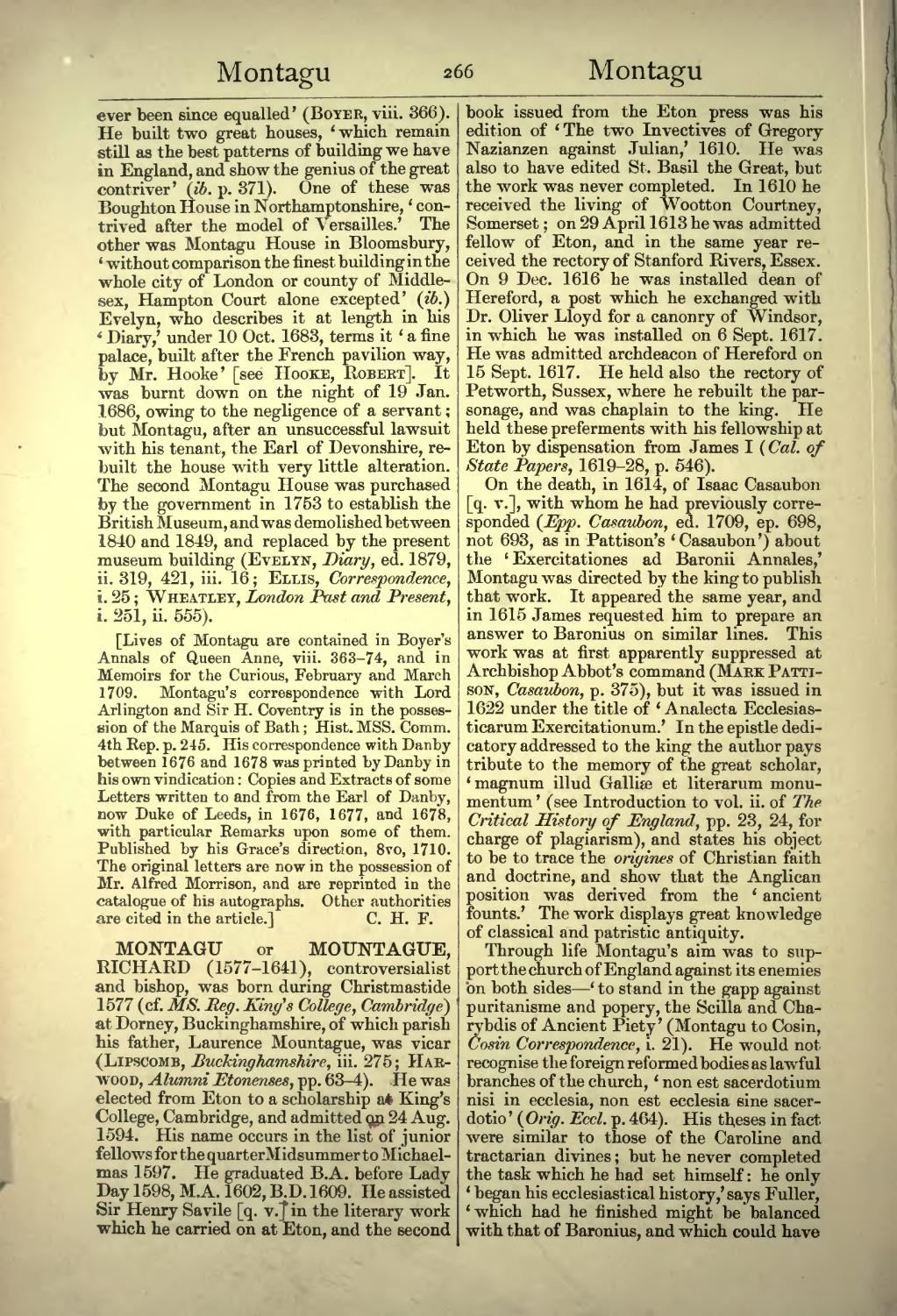ever been since equalled' (Boyer, viii. 366). He built two great houses, 'which remain still as the best patterns of building we have in England, and show the genius of the great contriver' (ib. p. 371). One of these was Boughton House in Northamptonshire, 'contrived after the model of Versailles.' The other was Montagu House in Bloomsbury, 'without comparison the finest building in the whole city of London or county of Middlesex, Hampton Court alone excepted' (ib.) Evelyn, who describes it at length in his 'Diary,' under 10 Oct. 1683, terms it 'a fine palace, built after the French pavilion way, by Mr. Hooke' [see Hooke]. It was burnt down on the night of 19 Jan. 1686, owing to the negligence of a servant; but Montagu, after an unsuccessful lawsuit with his tenant, the Earl of Devonshire, rebuilt the house with very little alteration. The second Montagu House was purchased by the government in 1753 to establish the British Museum, and was demolished between 1840 and 1849, and replaced by the present museum building (Evelyn, Diary, ed. 1879, ii. 319, 421, iii. 16; Ellis, Correspondence, i. 25; Wheatley, London Past and Present, i. 251, ii. 555).
[Lives of Montagu are contained in Boyer's Annals of Queen Anne, viii. 363-74, and in Memoirs for the Curious, February and March 1709. Montagu's correspondence with Lord Arlington and Sir H. Coventry is in the possession of the Marquis of Bath; Hist. MSS. Comm. 4th Rep. p. 245. His correspondence with Danby between 1676 and 1678 was printed by Danby in his own vindication: Copies and Extracts of some Letters written to and from the Earl of Danby, now Duke of Leeds, in 1676, 1677, and 1678, with particular Remarks upon some of them. Published by his Grace's direction, 8vo, 1710. The original letters are now in the possession of Mr. Alfred Morrison, and are reprinted in the catalogue of his autographs. Other authorities are cited in the article.]
MONTAGU or MOUNTAGUE, RICHARD (1577–1641), controversialist and bishop, was born during Christmastide 1577 (cf. MS. Reg. King's College, Cambridge) at Dorney, Buckinghamshire, of which parish his father, Laurence Mountague, was vicar (Lipscomb, Buckinghamshire, iii. 275; Harwood, Alumni Etonenses, pp. 63-4). He was elected from Eton to a scholarship at King's College, Cambridge, and admitted on 24 Aug. 1594. His name occurs in the list of junior fellows for the quarter Midsummer to Michaelmas 1597. He graduated B.A. before Lady Day 1598, M.A. 1602, B.D. 1609. He assisted Sir Henry Savile [q. v.] in the literary work which he carried on at Eton, and the second book issued from the Eton press was his edition of 'The two Invectives of Gregory Nazianzen against Julian,' 1610. He was also to have edited St. Basil the Great, but the work was never completed. In 1610 he received the living of Wootton Courtney, Somerset; on 29 April 1613 he was admitted fellow of Eton, and in the same year received the rectory of Stanford Rivers, Essex. On 9 Dec. 1616 he was installed dean of Hereford, a post which he exchanged with Dr. Oliver Lloyd for a canonry of Windsor, in which he was installed on 6 Sept. 1617. He was admitted archdeacon of Hereford on 15 Sept. 1617. He held also the rectory of Petworth, Sussex, where he rebuilt the parsonage, and was chaplain to the king. He held these preferments with his fellowship at Eton by dispensation from James I (Cal. of State Papers, 1619-28, p. 546).
On the death, in 1614, of Isaac Casaubon [q. v.], with whom he had previously corresponded (Epp. Casaubon, ed. 1709, ep. 698, not 693, as in Pattison's 'Casaubon') about the 'Exercitationes ad Baronii Annales,' Montagu was directed by the king to publish that work. It appeared the same year, and in 1615 James requested him to prepare an answer to Baronius on similar lines. This work was at first apparently suppressed at Archbishop Abbot's command (Mark Pattison, Casaubon, p. 375), but it was issued in 1622 under the title of 'Analecta Ecclesiasticarum Exercitationum.' In the epistle dedicatory addressed to the king the author pays tribute to the memory of the great scholar, 'magnum illud Galliae et literarum monumentum' (see Introduction to vol. ii. of The Critical History of England, pp. 23, 24, for charge of plagiarism), and states his object to be to trace the origines of Christian faith and doctrine, and show that the Anglican position was derived from the 'ancient founts.' The work displays great knowledge of classical and patristic antiquity.
Through life Montagu's aim was to support the church of England against its enemies on both sides 'to stand in the gapp against puritanisme and popery, the Scilla and Charybdis of Ancient Piety' (Montagu to Cosin, Cosin Correspondence, i. 21). He would not recognise the foreign reformed bodies as lawful branches of the church, 'non est sacerdotium nisi in ecclesia, non est ecclesia sine sacerdotio' (Orig. Eccl. p. 464). His theses in fact were similar to those of the Caroline and tractarian divines; but he never completed the task which he had set himself: he only 'began his ecclesiastical history,' says Fuller, 'which had he finished might be balanced with that of Baronius, and which could have
